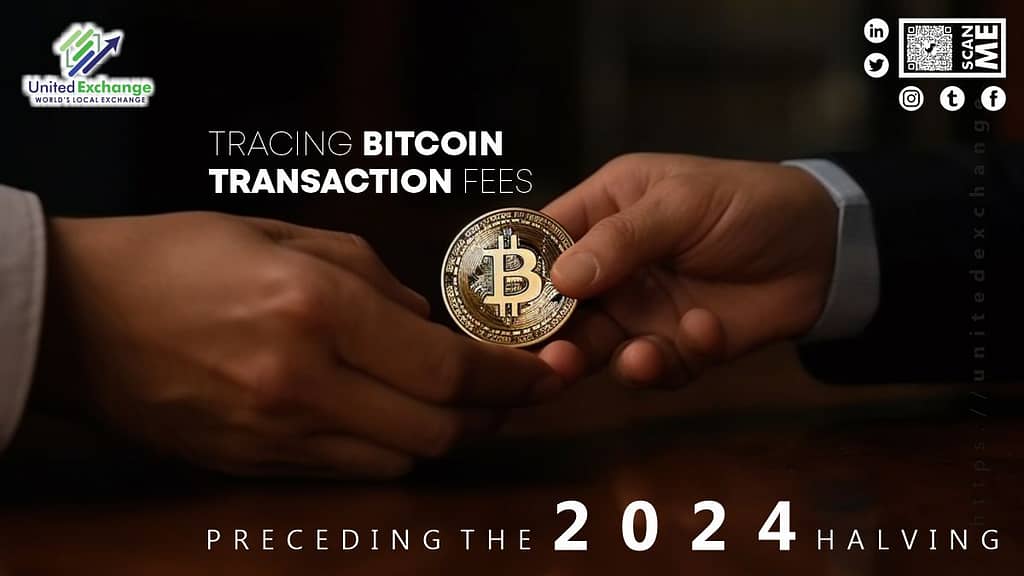Introduction:
As the Bitcoin ecosystem braces for the highly anticipated 2024 Halving, traders and enthusiasts alike are scrutinizing every aspect of the blockchain’s dynamics, particularly transaction fees. Amidst this fervor, United Exchange is a leading platform for cryptocurrency trading. This platform emerged as a beacon of insight, shedding light on the trends preceding this pivotal event. In this comprehensive analysis, we delve into United Exchange’s data to unravel the intricacies of tracing Bitcoin transaction fees preceding to the Bitcoin Halving 2024.
Understanding Bitcoin Transaction Fees:
Bitcoin transaction fees play a crucial role in the network’s functioning, serving as incentives for miners to include transactions in blocks. These fees are determined by various factors, including network congestion, block size, and user preference for transaction speed. Consequently, monitoring transaction fee trends provides valuable insights into the underlying dynamics of the Bitcoin network.
Analyzing Historical Bitcoin Fee Trends
Bitcoin stands tall as the pioneer and the most prominent player. As the popularity of Bitcoin continues to soar, so does the importance of understanding its fee dynamics. In this comprehensive analysis, we delve into the historical trends of Bitcoin fees on United Exchange, shedding light on crucial insights for investors, traders, and enthusiasts alike.
Understanding Bitcoin Fees
Before delving into historical trends, it’s imperative to grasp the basics of Bitcoin transaction fees. Bitcoin, unlike traditional fiat currencies, operates on a decentralized network powered by blockchain technology. Each transaction on the Bitcoin network requires a fee to be processed by miners, who validate and add transactions to the blockchain.
Bitcoin fees are determined by various factors, including network congestion, transaction size, and urgency. Users can choose to pay higher fees to expedite their transactions or opt for lower fees for less urgent transactions. The fee market on the Bitcoin network operates on a supply and demand basis, where higher demand for transactions results in increased fees.
Exploring United Exchange’s Data Insights:
United Exchange’s robust data analytics tools offer unparalleled visibility into Bitcoin transaction fees. This exchange has discovered fascinating insights and trends by examining transaction data leading up to the 2024 Halving. It offers traders and analysts valuable intelligence.
Key Findings:
Rising Transaction Fees:
Before the 2024 Halving, United Exchange noticed a steady rise in Bitcoin transaction fees. This surge is linked to a rising need for block space, as traders rush to process their transactions before the Halving.
Peak Activity Periods:
UE’s data reveals distinct peaks in transaction fees during specific periods preceding the Halving. These spikes coincide with heightened trading activity and increased speculation surrounding Bitcoin’s future trajectory.
Impact of Network Congestion:
As transaction volumes surge, network congestion becomes a significant factor influencing transaction fees. UE’s analysis underscores the correlation between congestion levels and fee escalation. It highlights the importance of scalability solutions in mitigating fee volatility.
Fee Optimization Strategies:
In the face of unpredictable transaction fees, This exchange has devised techniques to streamline transaction expenses. By employing sophisticated algorithms for fee estimation and adaptable fee adjustment systems, traders can better manage fee variations, facilitating prompt and economical transactions.
Temporal Variations:
United Exchange’s data reveals nuanced temporal variations in Bitcoin transaction fees in the run-up to the Halving. The platform offers traders a detailed comprehension of fee fluctuations across various time spans. It empowers them to seize advantageous moments in the market.
Fee Correlation with Market Sentiment:
Amidst the backdrop of market volatility, UE identifies a strong correlation between transaction fees and overall market sentiment. Bullish phases often coincide with heightened transaction fees as traders rush to capitalize on market movements, while bearish sentiments may trigger fee depressions as transaction volumes recede.
Implications for Traders and Investors:
United Exchange’s data-driven insights carry significant implications for traders and investors navigating the pre-Halving landscape. Utilizing these insights empowers market participants to make informed choices, minimizing risks while seizing emerging opportunities.
